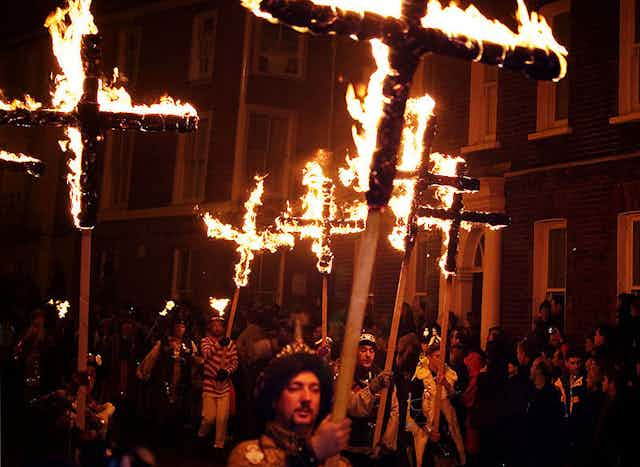If the BBC’s drama series Gunpowder, about the original Gunpowder Plot, has achieved anything, apart from turning people’s stomachs with its graphic, though accurate, portrayal of 17th-century torture practices, it has surely opened people’s eyes to the reality behind our annual firework fest on November 5. We may recite: “Remember, remember the fifth of November” but the truth is that, as a nation, Britain has long forgotten the seriousness of the event that, as it were, sparked it off.
The Gunpowder Plot was a Catholic terrorist conspiracy whose consequences, had it succeeded, hardly bear thinking of. Not only would the king and almost the entire apparatus of the state have been blown to pieces, but it would almost certainly have been the catalyst for civil war, possibly foreign invasion, and the deaths of many thousands of people.
The annual bonfire in November was not a celebration of key conspirator Guy Fawkes, as many people seem vaguely to imagine, but a condemnation of a murderous villain and an outpouring of relief at what the country had been saved from.
But that was in 1605. Does it make sense to continue the tradition 400 years later? The anti-Catholic aspect of it may have disappeared, but burning effigies still has the potential to stir up trouble. In Lewes, Sussex, home of the country’s most celebrated and elaborate bonfire celebrations, they gave up burning the Pope some years ago, but they have moved on to more contemporary bogey figures, including Osama bin Laden, Sepp Blatter and Donald Trump, while this year’s star turn is a giant effigy of Harvey Weinstein.
The inclusion of an effigy of the then Scottish first minister, Alex Salmond, in 2014 prompted a police inquiry. This year’s celebrations have provoked controversy because one of the processions includes a group blacked up as Zulu warriors, prompting accusations of racism from some, though an actual Zulu representative defended the practice and said the men looked surprisingly convincing.
At a time when statues of Confederate Civil War leaders are being torn down in the States and there are calls for the removal of images of prominent British imperialists, is it time to cool things down a bit and give the bonfires a rest?
Staring at the flames
Staging celebratory and symbolic bonfires has a long history behind it. Even before Fawkes, Martin Luther – whose defiance of the Pope marks its 500th anniversary this year, staged a public bonfire of Catholic writings into which he also cast the papal bull proclaiming his excommunication – it was a practice emulated by the Nazis in their public burnings of books by Jewish and left-wing authors.
In late Victorian Cambridge a series of huge bonfires lit by undergraduates celebrating the defeat of the proposal to grant degrees to women and British victories in the Boer War presented a serious public order challenge to the town and university authorities. Bonfires seem to speak to a primeval reverence in people for fire itself, like a thanks offering to Prometheus, who had to steal fire from the gods, who were keeping it to themselves, and was suitably punished by them for his action.

Perhaps the gods were wise. Bonfires do excite powerful emotions and can literally inflame situations. Think of a possible modern-day equivalent to Guy Fawkes night – if, say, an Islamist attack or the defeat of Islamic State in Syria were to set off any celebratory bonfires in Britain, it is not difficult to conceive of the seriously divisive impact it would have.
On the other hand, banning traditional bonfires is a sure (surefire?) way of instilling resentment. November the fifth was for years an anti-Catholic festival – marking not just the Gunpowder Plot, but also the landing on that date in 1688 of the Protestant William of Orange to overturn the Catholic King James II. But over time it lost its sectarian nature and became just an enjoyable winter festival with fireworks and jacket potatoes. After all, the practice of lighting bonfires at this time of years has pagan origins, going way back before Guy Fawkes.
Even in Lewes, the annual festival is more about the town’s special identity because of the 12 Protestant martyrs burned there during the reign of Bloody Mary. There are seven different local bonfire societies who maintain a friendly rivalry to stage the most elaborate procession with the most impressive effigy. Periodic attempts to regulate it always provoke angry local responses.
Guy Fawkes night survives despite the onslaught of the heavily Americanised Halloween celebrations. It is a distinctively British tradition and it has survived by evolving and becoming domesticated, as perhaps only the British know how. Bonfires burn brightly and fiercely but even the biggest of them eventually burn themselves out and leave the smoking embers for the morning after. Perhaps fusses over bonfires should be treated the same way.

